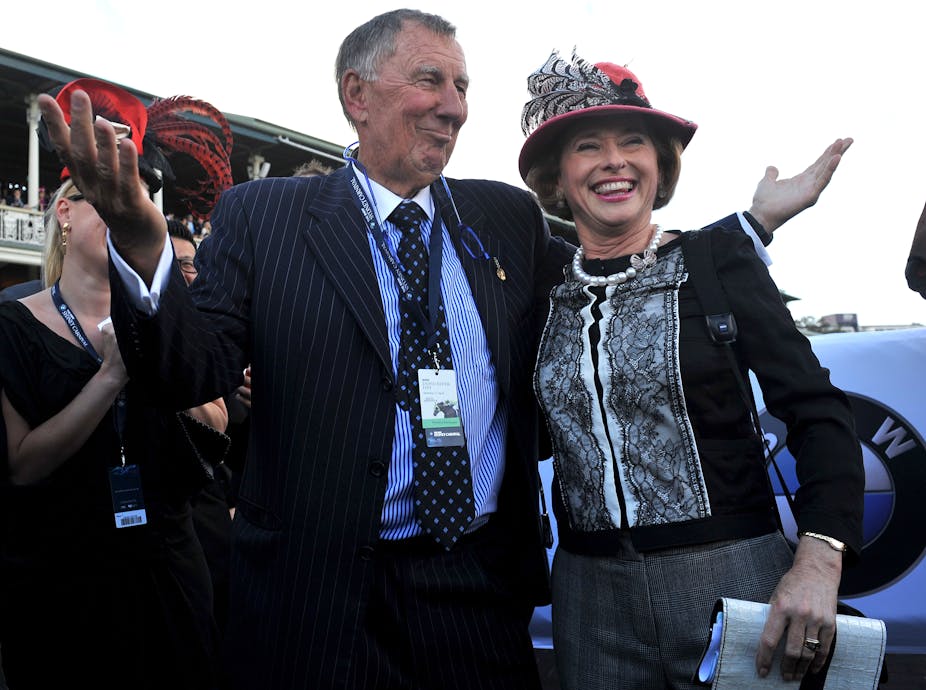The Gai Waterhouse-John Singleton horse racing imbroglio has the feel of fiction. Its cast of characters could easily spring from the treatment for a new Underbelly series or the pages of a Peter Corris novel. News and narrative have here aligned with rare precision.
The Racing NSW stewards hearing has provided rich material for imaginative play, generating multiple walk-on parts for actors described by others in the production as: the “drunk” (John Singleton), the “trumped-up jockey” (Allan Robinson), the “brothel owner” (Eddie Hayson), the “footballer” (Andrew Johns), the “bookie” (Tom Waterhouse), the “snob” and “failed actress” (Gai Waterhouse). Its participants have played to the gallery, feeling “like rock stars” (in Singleton’s words) while competing for nightly news grabs.
Although this is a national story, its context is unmistakeable. The main character of this mediated melodrama is Sydney itself. Should Leviathan, John Birmingham’s rambunctious unauthorised biography of Sydney, deservedly go to a new edition, it would surely contain a vivid portrait of 21st century Sydney as seen through the More Joyous affair.
Birmingham quotes the archetypal Sydney “character”, William Charles Wentworth, who in 1824 held that:
Scandal appears to be a favourite amusement to which idlers resort to kill time and prevent ennui, and, consequently, the same families are eternally changing from friendship to hostility, and from hostility back to friendship again.
Wentworth might have written those same words today for an upmarket magazine or edgy blog in describing the Waterhouse-Singleton daily spectacle of frayed friendships and tentative reconciliations.
What does the current scandal tell us about Sydney past and present, and its place within the national imagination? Despite Melbourne’s own rich history of scandal and transgression, it is Sydney that has assumed and retained the mantle of Australia’s “Sin City”. Sydney is enduringly characterised by a residual freewheeling, colonial, “whatever it takes” lawlessness coupled with a brazen, aggressively unenlightened self-interest.
It is notable that Singleton versus Waterhouse has occurred at a time when another very Sydney matter has been played out in the daily national news. The NSW Independent Commission Against Corruption (ICAC) inquiry into the awarding of lucrative mining leases - with its daily revelations of long lunches and friends with benefits - has reinforced long-held views that the spirit of the Rum Corps still runs through the city like the Tank Stream (now a drain) below it.
Horse racing has played more than a bit part in this dubious civic reputation. The “sport of kings” has always been a confusing mixture of establishment respectability, genuine equine affinity, working class “vocabularies of hope”, celebrity attention seeking, and dubious connections.
But the figure of the “colourful racing identity” is essentially a Sydney invention, a defamation-defying euphemism for its roll call of SP bookies, loan sharks, bent politicians, “whale” wagerers and their associates. Its vivid tableau of spivs and mug punters resonates well with an image of place where the odds are seen to be loaded against honest citizens in favour of more worldly rule benders and influence peddlers.
The current controversy over the promotion of sport gambling on television is not mainly about horse racing or focused on Sydney. The terms of reference for the Senate inquiry into “the advertising and promotion of gambling services in sport” are generic, referring only to “in-game promotion and the integration of gambling into commentary and coverage”, “exposure to, and influence on, children”, the “effect on the integrity of, and public attitudes to, sport”, and so on.

Yet in public debate on the issue, the Waterhouse name – and especially Tom, scion of the bookmaking dynasty - has been much in evidence. It is the omnipresence of Waterhouse’s youthful, smiling visage in and outside sport broadcasts, and his use as a faux television sports commentator to promote gambling on sport, that has given additional impetus to anti-gambling campaigns.
Tom makes much of being “born to bet”, but understandably less of the part of his patrimony that saw his grandfather Bill and father Robbie - both bookmakers - warned off racecourses after the 1984 Fine Cotton affair.
The prominence of Waterhouse in the national controversy about sport and betting inevitably evoked the image of Sydney as a place where “anything goes”. When the Sydney-based Channel Nine and Tom Waterhouse stretched the TV-sport-gambling trifecta to its limit, it was easily read as the national dissemination of this Sydney ethos.
When allegations (as noted, furiously contested) were made that Tom had conferred with his mother Gai over the health of Singleton’s horse More Joyous, there was more focus on the noisy spat than surprised concern at what had been alleged. Sydney, for many, was just acting the part.
David Williamson’s characterisation of Sydney in Emerald City “as New York without the intellect” is oftencited as a put-down. But there are many in Australia, and some of the city’s own residents, who would award it the status of documentary. As events at Randwick unfold, we are witnessing a very Sydney tale that’s been running far longer than The Mousetrap.

